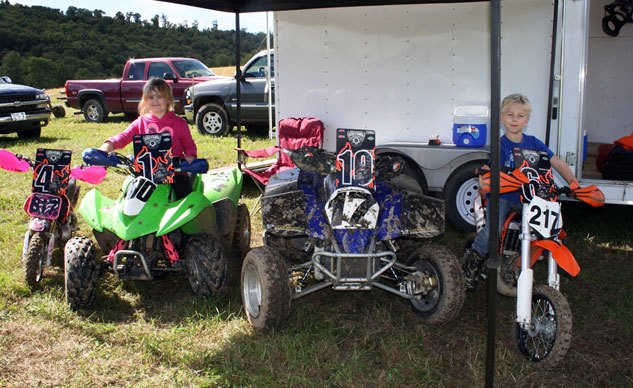Head Shake - Youth Movement
A decade or three ago, I noticed a trend that I found kind of amusing whilst laboriously combing through an annual set of Motorcycle Industry Council stats (yawn). The average age of your typical American motorcyclist was me. And over the years I noticed something else that remained fairly constant over time – like decades of time – that demographic novelty has remained true; as I aged, so did the average age of the American motorcyclist. And finally, after the passage of a number of years, something else came ringing home, worrisome, much as I might like to deny it: I am getting quite old.
Where were we? Oh, right. This concerns me, not the getting older part, I suppose that’s alright, it beats the alternative most days, but I’m genuinely concerned for the continued vitality of the U.S. motorcycle market. Why would I care? Because I want to see a wide array of affordable and available bikes for us all to enjoy, and people have a lot of different tastes in these matters. For that to happen this motorcycling endeavor, sport, pastime, recreation, call it whatever you want … for this to happen we absolutely must start trending that age demographic downward.
Now all is not doom and gloom. I see a collection of forces coming together that might just help spur on the next generation of riders. Here are a few things that give me hope:
First, the manufacturers are offering a plethora of entry-level bikes that any neophyte rider could approach without feeling like he’s launching an F/A-18 off the deck of the USS Ronald Reagan. This is good, and the prices are good, and the financing plans are currently favorable, given the swell state of our economy and the Fed being the Fed.
Second, more and more women have been getting involved in motorcycling. This is a fantastic thing. It has been going on for some time now and is a positive development from the starting grid to the Interstate. We need that diversity so as not to end up a bunch of geezers sitting around sucking our teeth, literally or metaphorically, and bitching about the government.
And third, a quality that I don’t think will ever disappear off the face of this Earth. There are Type-A personalities, there are adventurers and dreamers, there are wanderers, and there always will be. That, pure and simple, is motorcycling material. They need an outlet, and what could be better than two wheels?
Look at any start grid and you can see it. Think about yourself or your friends, for that matter go back and look at the MO staffers: a disproportionate amount of racers and ex-racers (7 out of 8 of them!), a disproportionate amount of U.S. military veterans (4 out of 8) – what kind of idiot joins up freely to any organization to get a bad haircut and become a moving target? – and a surprising amount of folks with some level or another of a legal background, which is a Type-A environment if I ever saw one. The point being, Type-A types didn’t end with us. Adventurous kids still exist and they always will. So let’s train ’em up and put ’em on bikes!
The importance of it is simply this, if endurance racing taught me one thing, it is that the clock is always running. It never stops but it can run out. That age demographic I spoke about earlier? We’re not going to be around forever, so we need younger folks to get involved in riding; it’s no more complicated than that. The future of motorcycling ultimately rides with them, not with us older dudes.
I have other reasons to be hopeful as well. With Wayne Rainey, et. al., taking over AMA Pro Road Racing? Well, put it this way: I suspect we will see an improvement, and I’m hoping we see a huge improvement, maybe even a resurgence. Is that going to happen? I really don’t know. But I do know this, if the average motorcyclists spends money on their passion? Road racers spend ridiculous amounts of money on bikes, parts, aftermarket gear, and they influence their friends and fans to do likewise. It would be truly fabulous to see three- or even four-wave starts again, and a thriving race series serving as a breeder reactor for American talent.
While I’m dreaming I might as well go long, just sling it for the end zone. I’d love to see the return of real contingency programs, spec classes, something like the old GSX-R Cup, anything to encourage folks to step up and go racing and make it viable for them. The trickle-down effect from that could be huge, again.
Anyway, if I sound like Mr. Smith Goes to Washington and make you think of Jimmy Stewart pleading for a boys camp or some such, it is probably because that’s not far off the mark. Some serious contingency money would be a big deal, it would boost the sport, and I would imagine be quite beneficial to the manufacturers as well.
If all these things come together, and people follow their passions, the future of motorcycling in this country will be secure. And it should be, because there will always be that one kid who just wants to go ride more than anything in the world. He or she really should have that chance, and the major players can help shape that future, while making a good living at the same time.
Just a few months back a young lady came back from overseas study and wanted to take an MSF course, but she needed a lid, so I lent her one of mine with a WERA tech sticker on the front of it. I had to chuckle at that. I’d like to think one of the instructors glanced at that helmet and knew what it was. But in any case it was passing the torch. Let’s keep that flame alive.
Ride hard, stay safe, look where you want to go.
About the Author: Chris Kallfelz is an orphaned Irish Catholic German Jew from a broken home with distinctly Buddhist tendencies. He hasn’t got the sense God gave seafood. Nice women seem to like him on occasion, for which he is eternally thankful, and he wrecks cars, badly, which is why bikes make sense. He doesn’t wreck bikes, unless they are on a track in closed course competition, and then all bets are off. He can hold a reasonable dinner conversation, eats with his mouth closed, and quotes Blaise Pascal when he’s not trying to high-side something for a five-dollar trophy. He’s been educated everywhere, and can ride bikes, commercial airliners and main battle tanks.
More by Chris Kallfelz




































Comments
Join the conversation
Great story Chris... and I am guessing that many of the folks reading it will understand your scenario and more importantly the image of you sitting atop the gas tank of your grandfather's Honda. I am also guessing that there are many many enthusiast riders out there including yours truly that share a photo and an opportunity given us to enjoy the thrill of motorcycles at a very young age. It's also I believe an experience that we remember often as the spark that made and changed lives for ever. My Point: Cultivate that shared enthusiasm of our kids, our kid's kids and their friends by taking the time to share a ride on your motorcycle. Every motorcycle rider alive remembers their first ride on a motorcycle. That experience is something we should continue to share at every opportunity.
Bill Kniegge
Blue Strada Tours
Wheel Jockey
Important issue, for sure. A more safety conscious culture may have contributed (at least in America, how do other nations numbers compare?). The awesomely low death toll in MotoGP could be an indicator of elevated safety mindedness (a great thing, by the way)(also, anybody know accident rate per capita trends over time for racing? how do they compare to fatality rates?).
As far as I understand it, there were a lot of innovations that led to a smaller fatality rate in MotoGP (most accessible example data), but wider run-off area contributed greatly (I think my source is "Faster (2003)"). Are street circuits races and racers falling off because of the safety comparison (asking a question and proposing an idea based on the unknown answer)? Is sanctioned street racing more accessible to start amateur racers off?
I think the rise in popularity of supermoto (and smaller displacement road races, e.g. minis) sure might help generate interest from amateur riders, especially with the much cheaper price tag and you still get to blast around a track. The smaller track area also means a track is easier to maintain and build. I don't know how fast these races are, but a slower speed would also help enthusiasts more comfortably become acquainted with racing.
Americans also tend, more and more, to live in urban areas compared to rural areas. I know when I was a kid in a rural town a dirt bike was more common than one would ever see in the city (a right of passage and childhood status symbol). Could this contribute? I rarely see motor rec areas as much as I see city parks; a pay-for-track-access model might be too cost prohibitive for young parents to start kids on bikes (tracks normally have stiffer equipment/safety requirements than only-bike-needed backyards) and also to develop the rec areas.
Obesity and a sedentary lifestyle, especially in children, may also contribute to the aging average biker (source: http://en.wikipedia.org/wik.... Motorcycles might be an easier sell to kids for outdoor activity since children might think there is less exercise... just a thought if you're a parent that has trouble getting a kid out the door.